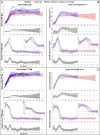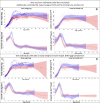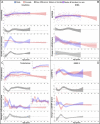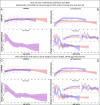Evidence for adolescent length growth spurts in bonobos and other primates highlights the importance of scaling laws
- PMID: 37667589
- PMCID: PMC10479963
- DOI: 10.7554/eLife.86635
Evidence for adolescent length growth spurts in bonobos and other primates highlights the importance of scaling laws
Abstract
Adolescent growth spurts (GSs) in body length seem to be absent in non-human primates and are considered a distinct human trait. However, this distinction between present and absent length-GSs may reflect a mathematical artefact that makes it arbitrary. We first outline how scaling issues and inappropriate comparisons between length (linear) and weight (volume) growth rates result in misleading interpretations like the absence of length-GSs in non-human primates despite pronounced weight-GSs, or temporal delays between length- and weight-GSs. We then apply a scale-corrected approach to a comprehensive dataset on 258 zoo-housed bonobos that includes weight and length growth as well as several physiological markers related to growth and adolescence. We found pronounced GSs in body weight and length in both sexes. Weight and length growth trajectories corresponded with each other and with patterns of testosterone and insulin-like growth factor-binding protein 3 levels, resembling adolescent GSs in humans. We further re-interpreted published data of non-human primates, which showed that aligned GSs in weight and length exist not only in bonobos. Altogether, our results emphasize the importance of considering scaling laws when interpreting growth curves in general, and further show that pronounced, human-like adolescent length-GSs exist in bonobos and probably also many other non-human primates.
Keywords: Pan paniscus; evolutionary biology; length growth; ontogeny; physiological non-invasive marker; scaling issues; weight growth.
© 2023, Berghaenel, Stevens et al.
Conflict of interest statement
AB, JS, GH, TD, VB No competing interests declared
Figures










Update of
- doi: 10.1101/2023.01.26.525764
- doi: 10.7554/eLife.86635.1
- doi: 10.7554/eLife.86635.2
Similar articles
-
Within arm's reach: Measuring forearm length to assess growth patterns in captive bonobos and chimpanzees.Am J Phys Anthropol. 2016 Sep;161(1):37-43. doi: 10.1002/ajpa.23004. Epub 2016 May 3. Am J Phys Anthropol. 2016. PMID: 27143225
-
Age-related changes in urinary testosterone levels suggest differences in puberty onset and divergent life history strategies in bonobos and chimpanzees.Horm Behav. 2014 Aug;66(3):525-33. doi: 10.1016/j.yhbeh.2014.07.011. Epub 2014 Jul 30. Horm Behav. 2014. PMID: 25086337
-
Evolution of human growth spurts.Am J Phys Anthropol. 1996 Dec;101(4):455-74. doi: 10.1002/(SICI)1096-8644(199612)101:4<455::AID-AJPA2>3.0.CO;2-V. Am J Phys Anthropol. 1996. PMID: 9016361
-
Female contributions to the peaceful nature of bonobo society.Evol Anthropol. 2011 Jul-Aug;20(4):131-42. doi: 10.1002/evan.20308. Evol Anthropol. 2011. PMID: 22038769 Review.
-
Locomotion in bonobos (Pan paniscus): differences and similarities between bipedal and quadrupedal terrestrial walking, and a comparison with other locomotor modes.J Anat. 2004 May;204(5):353-61. doi: 10.1111/j.0021-8782.2004.00292.x. J Anat. 2004. PMID: 15198700 Free PMC article. Review.
Cited by
-
A non-invasive measure of bone growth in mammals: Validating urinary CTX-I as a bone resorption marker through long-bone growth velocity in bonobos.Ecol Evol. 2024 Sep 23;14(9):e70326. doi: 10.1002/ece3.70326. eCollection 2024 Sep. Ecol Evol. 2024. PMID: 39315301 Free PMC article.
-
Restructuring of Femoral Cortical Bone During Growth and Locomotor Development of Wild Chimpanzees (Pan troglodytes verus).Am J Biol Anthropol. 2025 Jan;186(1):e25045. doi: 10.1002/ajpa.25045. Epub 2024 Nov 30. Am J Biol Anthropol. 2025. PMID: 39614779 Free PMC article.
-
Cofeeding at rich clumped food patches in free-ranging dogs: social tolerance or scramble competition?Behav Ecol Sociobiol. 2025;79(4):51. doi: 10.1007/s00265-025-03590-8. Epub 2025 Apr 14. Behav Ecol Sociobiol. 2025. PMID: 40242211 Free PMC article.
References
-
- Abràmoff MD, Magalhães PJ, Ram SJ. Image processing with ImageJ. Biophotonics International. 2004;11:36–42.
-
- Alberti C, Chevenne D, Mercat I, Josserand E, Armoogum-Boizeau P, Tichet J, Léger J. Serum concentrations of insulin-like growth factor (IGF)-1 and IGF binding protein-3 (IGFBP-3), IGF-1/IGFBP-3 ratio, and markers of bone turnover: reference values for French children and adolescents and z-score comparability with other references. Clinical Chemistry. 2011;57:1424–1435. doi: 10.1373/clinchem.2011.169466. - DOI - PubMed
-
- Anzà S, Berghänel A, Ostner J, Schülke O. Growth trajectories of wild Assamese macaques (Macaca assamensis) determined from parallel laser photogrammetry. Mammalian Biology. 2022;102:1497–1511. doi: 10.1007/s42991-022-00262-2. - DOI
Publication types
MeSH terms
Substances
LinkOut - more resources
Full Text Sources
Miscellaneous

